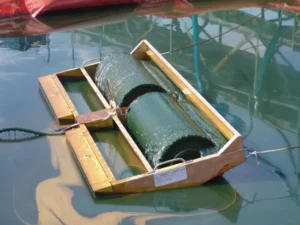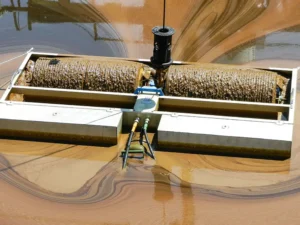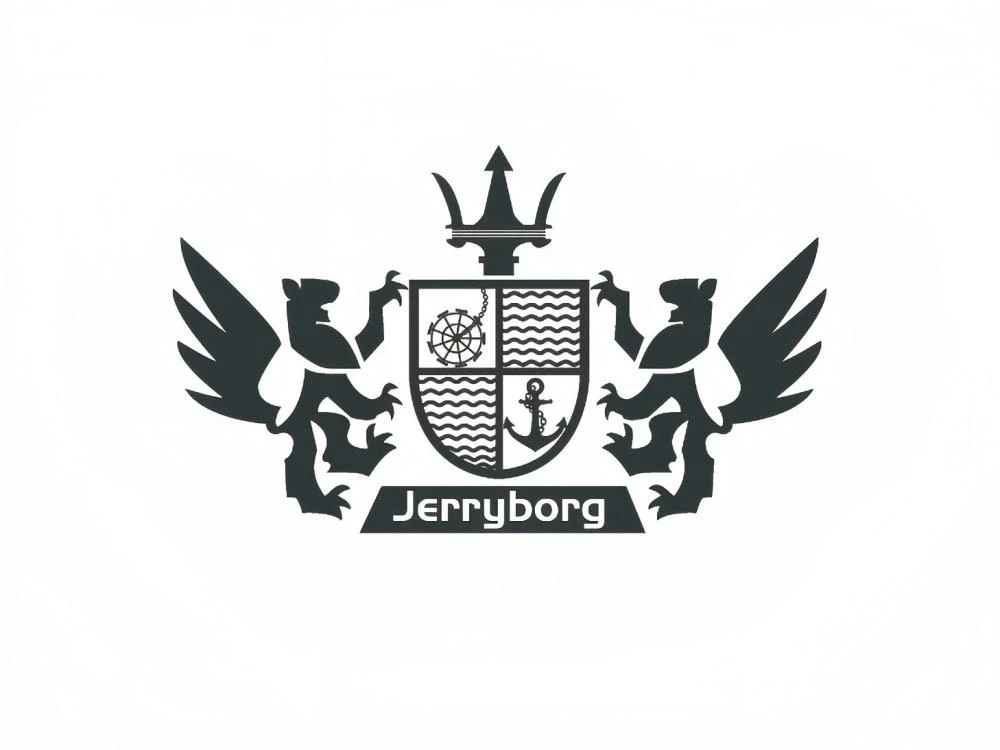La industria naval, formada por buques y embarcaciones, utiliza petróleo para sus operaciones. Esos buques consumen grandes cantidades de petróleo y pueden producir vertidos. Verter este aceite residual en el océano sería una idea peor. Podemos salvar el agua de este aceite utilizando distintos tipos de espumaderas de aceite.
Saber que este petróleo forma una capa en la superficie del agua es esencial. La capa de petróleo impide el suministro de oxígeno y luz solar a los animales marinos, lo que provoca la muerte de muchos animales. Sin embargo, podemos minimizar este riesgo mediante el espumado.
Pero lo que menos se entiende es el proceso de desnatado. Existen varios tipos de espumaderas. Es esencial reconocer cada tipo y utilizarlo en consecuencia. Este detallado artículo explorará todos esos tipos y cómo funcionan. Así que, ¡manos a la obra!
Desnatado de aceite

El peso específico es uno de los principios en los que se basa el desnatado. ¿Necesita conocer el peso específico? Es una relación de densidad entre dos fluidos. Uno es el fluido general y el otro es el fluido de referencia. El fluido de referencia para los líquidos es el agua.
En el proceso de desnatado se utilizan desnatadoras de gran potencia. Estas máquinas recogen el aceite y lo separan del fluido o del agua. Su nivel de utilización es accesible para diferentes refinerías de petróleo. Estas desnatadoras desempeñan un papel crucial en la eliminación del petróleo del agua durante el desnatado.
Las industrias marinas producen aceites residuales e hidrocarburos con menor gravedad específica. Por ejemplo, los grandes buques pueden verter el petróleo debido a un mal funcionamiento. Cuando los aceites usados se arrojan a los océanos, empiezan a flotar en la superficie, lo que constituye la primera y principal etapa de la separación del petróleo.
La tensión superficial es una propiedad que hace posible el espumado. Esta propiedad mantiene las moléculas del líquido fuertemente unidas. Cuando el aceite se escurre en el agua, la tensión superficial no permite que el aceite se hunda, por lo que el aceite permanece en la superficie del agua.
Aquí es donde entran en juego los skimmers. Se benefician de la tensión superficial y recogen el aceite en la superficie, ya que ésta no deja que se hunda. En este sentido, los skimmers oleófilos (amantes del aceite) resultan muy útiles. Muestran amor y adherencia al petróleo, dejando el agua inalterada.
Tipos de desnatadores de aceite
Como ya he dicho, los skimmers desempeñan un papel crucial en la separación y eliminación del petróleo de la superficie del agua. Sin ellos, el proceso de desnatado quedaría incompleto. Hay dos tipos principales de desnatadores de aceite:
- Oleófilo (amante del aceite)
- Oleofóbica (sombrero de aceite)
Además, cada uno tiene diferentes subtipos. Analizaremos cada uno de esos subtipos en la sección siguiente.
1- Espumaderas de disco (oleofílicas)
Los skimmers de disco contienen un gran número de discos para atraer el aceite. Sin embargo, algunos desnatadores de disco tienen discos individuales. La cantidad de aceite que se separa determina su uso. Espumaderas de aceite de disco Funcionan idealmente con petróleo de viscosidad baja o media. También pueden trabajar en mar abierto para salvar la vida de los animales marinos.
Averigüemos cómo funcionan estos desnatadores. Los skimmers de disco son oleófilos, lo que significa que sólo atraen el aceite, no el agua. Cuando se introduce en mar abierto, el disco empieza a girar. El aceite se adhiere al disco, dejando el agua atrás. Estos discos siguen girando repetidamente hasta que recogen una gran cantidad de aceite.
2- Desnatadores de bidones (oleofílicos)

Las desnatadoras de bidones se activan mediante un sistema hidráulico y la fuerza del viento. Las empresas las utilizan en lugares peligrosos, como en medio del océano. Con la ayuda de las desnatadoras de bidones, puede separar rápidamente galones de gasóleo y petróleo crudo.
Al igual que las espumaderas de disco, las de tambor son oleofílicas. Constan de grandes tambores que se conectan a la electricidad para girar. Cuando empiezan a girar, estos grandes tambores atraen el aceite. Pequeñas máquinas especializadas retiran el aceite de cada tambor.
Este aceite se recoge en un depósito. Ahora, están listos para una nueva vuelta de rotación. El uso principal de estas desnatadoras de tambor es en entornos marinos, donde separan grandes cantidades de aceite.
3- Desnatadores de banda (oleofílicos)
Los desnatadores de cinta se componen de determinados tipos de cintas. Estas cintas tienen un diseño sencillo y están enrolladas en un bucle. Las grandes empresas utilizan estos desnatadores en grandes masas de agua, como océanos y lagos pequeños.
Sin embargo, las industrias marinas los utilizan cerca de playas con poca agua. Los skimmers de cinta funcionan según el principio de la tensión superficial. Como he dicho antes, el agua y el aceite tienen tensiones superficiales diferentes, y estos desnatadores aprovechan esta diferencia.
Cuando le das corriente, la correa empieza a girar. La cinta sale del bucle, recoge aceite, lo vierte en el depósito y vuelve a girar. Repitiendo el proceso se recoge una gran cantidad de aceite.
4- Desnatadores de tubo (oleofílicos)
Los skimmers de tubo son la mejor opción para recoger petróleo de la costa oceánica. Consisten en grandes tubos cerrados por un extremo. Estos tubos sólo funcionan en aguas bajas. La ventaja de estos skimmers es que pueden trabajar mucho tiempo sin parar.
Además, sólo necesita un pequeño suministro de energía para funcionar. Como ya he dicho, los tubos especiales que atraen sólo el aceite constituyen los desnatadores tubulares. Utilizan el mismo principio de tensión superficial. El tubo comienza a girar y pega el aceite durante cada rotación. A los tubos se acoplan unos succionadores técnicos que recogen el aceite del tubo después de cada vuelta.
5- Desnatadores de cepillo (oleofílicos)
Los skimmers de cepillo están fabricados con cepillos especiales hechos de un material único y robusto. Lo mejor de estos skimmers es que pueden soportar los golpes de las espirales. Por eso se utilizan en océanos profundos para limpiarlos de petróleo. Pueden recoger tanto petróleo pesado como ligero.
Estos skimmers son oleófilos. Giran para recoger el aceite de la superficie del agua. Después de cada rotación, el aceite se recoge en el recipiente. Los cepillos se enjuagan y se vuelven a enviar para recoger más aceite. Estos skimmers son muy eficaces y recogen el aceite rápidamente.
Lo más destacado: Estos skimmers son muy eficaces en los océanos profundos, ya que pueden soportar la carga de las olas. Muchas especies marinas, como los peces, pueden salvarse en esta zona. Además, estos skimmers tienen distintos tamaños, y la empresa puede utilizarlos según sus necesidades.
6- Espumaderas de succión (oleofóbicas)
¿Ha visto una aspiradora? Los desnatadores de succión son como ellos. Constan de bombas de gran potencia que aspiran el petróleo en grandes cantidades. Los fabricantes diseñan estos desnatadores para barcos, buques, cruceros y la industria de refinería de petróleo.
Sobre todo, pueden recoger tanto petróleo pesado (crudo) como ligero (gasóleo). Se puede ajustar su succión en función de cada aceite. Además, son fáciles de usar gracias a sus modelos. He dicho anteriormente que estos desnatadores funcionan según el principio de los aspiradores.
Contienen una gran bomba que produce succión. Se puede ajustar la potencia de succión según los tipos de aceite. Cuando el cabezal de succión se deja caer en el agua, aspira el aceite tanto de la superficie como de las profundidades. Cuando sale del agua, contiene una gran cantidad de aceite.
7- Desnatadores Weir (Oleofóbicos)

Weir significa "barreras". Como su nombre indica, estos skimmers están formados por barreras únicas. Estas barreras recogen el petróleo del agua. Estos skimmers son prácticos en aguas tranquilas, lo que significa que puede utilizarlos eficazmente para limpiar de petróleo las playas y costas.
La principal ventaja de estos desnatadores de presa es que tienen componentes elementales fáciles de limpiar y reparar. Los skimmers de presa utilizan el principio de la gravedad para funcionar. Como ya se ha mencionado, constan de barreras. Tienen un efecto gravitatorio especial sobre los aceites.
Estas barreras recogen el aceite y lo envían al compartimento especial para su recogida. Por el contrario, el agua se desliza sobre la barrera y casi se recupera. Los skimmers de presa son oleófobos. También recogen agua con aceite, por lo que pueden tardar más tiempo en separar el agua del aceite. En resumen, estos skimmers pueden trabajar más lentamente en comparación con otros tipos.
¿Por qué necesita la industria naval desnatadores de aceite?
Casi todas las industrias utilizan petróleo para sus operaciones. La industria naval no es una excepción, ya que los barcos y buques utilizan una gran cantidad de petróleo. Además, muchas otras máquinas lo consumen. Sin embargo, su liga y vertido pueden arrojar grandes cantidades de petróleo al agua. Sin embargo, arrojar a aguas abiertas cualquier fluido que contenga contaminantes de petróleo es ilegal.
Es peligroso para la salud humana y agota el entorno natural. Por eso, para eliminar ese aceite, la industria naval utiliza desnatadoras de aceite en su beneficio. Además, las refinerías de petróleo también los utilizan para purificar los aceites. Hay que tener en cuenta que esas referencias producen aceite impuro. Su purificación es fundamental, y las industrias utilizan skimmers para este fin.
No nos equivocaremos si decimos que las industrias marinas consideran que los skimmers son imprescindibles. Utilizan la mayoría de los skimmers avanzados. En primer lugar, necesitan skimmers para sus barcos. El petróleo crudo puede dañar las partes integrantes de los buques, lo que puede provocar graves accidentes. Además, si las industrias marinas no utilizan desnatadores de petróleo, causarán graves problemas medioambientales.
Preguntas frecuentes
¿Cuántos tipos de skimmers hay?
Existen siete tipos comunes de espumaderas. Cada tipo tiene un principio de funcionamiento específico. Además, cada tipo es específico para trabajar en distintos entornos.
¿Qué espumadera es adecuada para el petróleo pesado?
Para limpiar el petróleo pesado se utilizan desnatadores de succión y desnatadores de cinta. Disponen de maquinaria especializada que les ayuda a eliminar el petróleo pesado de las masas de agua.
¿Qué es un desnatador de aceite?
Un desnatador de aceite es un dispositivo que separa el aceite del agua. Se utiliza en diversas industrias, como refinerías de petróleo y sectores marinos.
¿Cuál es el principio de un desnatador de aceite?
La desnatadora de aceite funciona según el principio de gravedad y tensión superficial. El aceite tiene menor tensión superficial que el agua, por lo que empieza a flotar en la superficie. Estas máquinas recogen esta capa de aceite de la superficie.
Conclusión
La contaminación es un problema importante, y su impacto también afecta a la vida marina. Si el petróleo permanece en el agua, afectará a la vida acuática. Pero los skimmers son los verdaderos salvadores en esta situación, salvando nuestro planeta de la contaminación. En este artículo, he cubierto casi todos los tipos de skimmers.
Hay skimmers de todos los tipos, desde los más sencillos hasta los más avanzados. Reducen los esfuerzos humanos para mantener limpio el medio ambiente y están disponibles en todos los tamaños. Puede utilizar diferentes tipos de métodos de limpieza de petróleo en las playas e incluso en las profundidades del océano.
